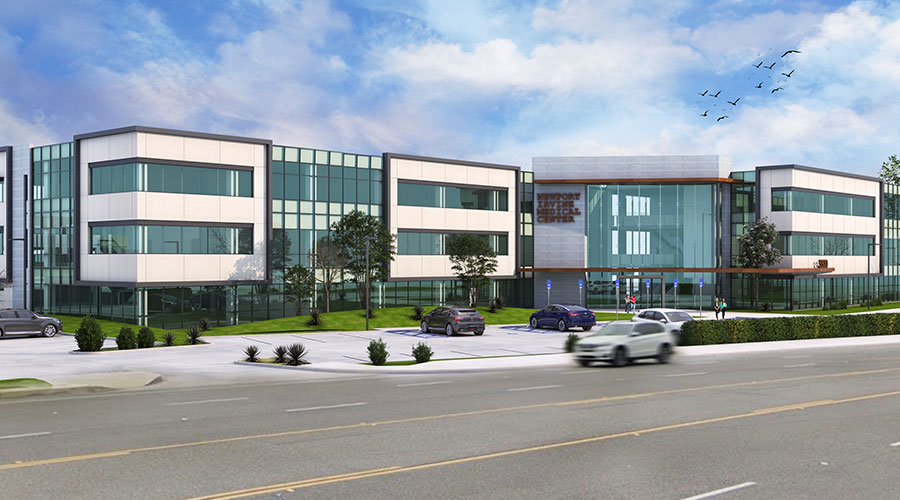One of the best ways to support hospital staff is to design a built environment that supports taking the right action. For instance, it is essential that staff be able to concentrate in medication rooms, where interruptions or even casual interactions can contribute to medication-related errors. A design solution? Narrow the hallway to discourage gatherings and conversations, and relocate common areas that might be nearby.
Much has been written on the benefits of large windows, natural light, soothing views and convenient staff break areas. All of these are true, but one of the best, most tangible ways to support staff – especially tired, overloaded, stressed healthcare workers – is through design where the default is easier, safer and correct actions. Fewer mistakes means better care.
Surroundings matter
In the past, the status quo was for clinicians to purport not to care or even notice the conditions of their workplaces.
“They say, 'We don’t care about the color of the walls,’ or ‘It doesn’t matter that there are no windows, I’ll be fine working in a dungeon,’” says Nora Colman, a Page physician advisor and pediatrician. “We’re all used to healthcare designers trying to create spaces that engage and comfort patients and families, that are not so stark and bare. But clinicians are starting to see how the environment affects them, as well, from having a place to stash their personal items to how far they must walk to get supplies. The built environment impacts staff satisfaction, burnout and retention.”
Healthcare architects and medical designers know that burnout impacts individuals, but it is rooted in systems: operational, relational and environmental. Design can both improve operational and relational dynamics and address the environmental aspect of staff wellness.
One design does not fit all
Some healthcare workers thrive from taking their breaks in a staff lounge, chit-chatting and socializing with work friends. A variety of furniture and seating options, such as living room and dining room arrangements with large tables in front of windows, allows employees to gather to promote a community spirit and encourages them to spend their downtime with colleagues.
But everyone re-energizes differently. Others need solitude, a space that is quiet with minimal stimulation and soft, low-level lighting. This environment can provide respite that helps calm minds and redirect thoughts.
Wellness involves more than attention to physical well-being. It is also connected to state of mind. In addition to the way the physical environment can promote spaces for improved fitness, conversations are emerging around the recognition of neurodiversity in the workplace. Spaces should support various ways to think, learn and interact, including the multiple ways for individuals to rest and recharge.
Design for comfort and wellness
The physical environment can impact a person’s emotional state. Stepping from a dark, cloistered space into an open space with greenery and natural light tends to lift a person’s mood.
Moving from one spectrum to another can involuntarily help reset the mind, re-orienting and refreshing it. This transition can and should happen not only in lounges and respite rooms but in hallways, conference rooms and meeting rooms.
Digital screens with nature images or abstract movement can relax or distract, and oversized art is often preferable to blank walls. Elements from wall and floor colors to clear, intuitive wayfinding and welcoming furnishings impact the comfort of patients and visitors but also staff — the ones who spend most of their working hours in these spaces.
“Design has as profound an impact on human behavior and performance as it does on energy and the environment,” says Roseann Pisklak, Page’s lead interior designer. “Integrating wellness that’s holistic and preventative is ongoing. The physical improvements and strategic design clearly make a difference to occupants.”
Staff feedback
Feedback from healthcare facilities users on designing for wellness can be summarized in a few bullet points:
- Daylighting is a huge differentiator for staff.
- Respite rooms are appreciated when included in plans, but often they are squeezed into not ideal locations, such as next door to loud waiting areas or in areas that are not easily accessible.
- Food options matter. Staff use a hospital’s cafe because it can be inconvenient for them to go off site. Positioning cafes to promote healthy eating with food on display feels more like a restaurant and offers a community touchdown spot.
- Focus on outside greenery, since what designers can do with greenery on the inside is more limited. Designers no longer can include water features inside due to the risk of infections, but they still can be creative with outdoor waterscaping.
- Use digital walls, which can show water, nature and movement and can become spaces where designers can help people get out of their heads.
- Make the stairs a more accessible spot so it is easier and more convenient to take the stairs than the elevator for staff and others.
- Design can reinforce taking a water or coffee break at a nearby hydration station just for staff, where they can take a moment during their work. Healthcare staff tend to care for themselves last and need encouragement for self-care through design, or often it does not happen.
- As more tech companies come into play in hospitals, use some tech for staff wellness and support. Robots are taking over tasks, leaving more time for staff at the patient’s bedside.
- Clients see the value of aligning with organizations that promote person-centered healthcare principles that focus on the well-being of patients and staff.
One core aspect to remember when designing for healthcare staff is that they are human beings caring for other human beings with kindness and compassion. What does that mean for design? Designers must think about the building from the vantage point of every staff member working there. At the heart of that experience is empathy, which is the guiding principle that informs all design work.
Beth Carroll, AIA, ACHA, is regional healthcare director with Page in Dallas. Tushar Gupta, FAIA, is healthcare sector lead with Page in Houston.

 The Effect of Over-Cleaning on Human Health
The Effect of Over-Cleaning on Human Health Rumored Terror Threat to Hospitals Prompts FBI Warning
Rumored Terror Threat to Hospitals Prompts FBI Warning Ground Broken on New Johns Hopkins All Children's Hospital
Ground Broken on New Johns Hopkins All Children's Hospital States Move Forward to Better Protect Senior Citizens
States Move Forward to Better Protect Senior Citizens Archer and REDA to Transform Newport Beach Building into Outpatient Center
Archer and REDA to Transform Newport Beach Building into Outpatient Center